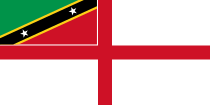Flag of Nevis
 |
|
| Use | National flag, civil and state ensign |
|---|---|
| Proportion | 2:3 |
| Adopted | September 19, 1983 |
| Design | A yellow-edged black diagonal band bearing two white five-pointed stars divided diagonally from the lower hoist-side corner to the upper fly-side corner: the upper triangle is green and the lower triangle is red. |
| Designed by | Edrice Lewis |

Variant flag of Saint Kitts and Nevis
|
|
| Name | Naval Ensign of Saint Kitts and Nevis |
| Use | Naval ensign |
| Proportion | 1:2 |
The flag of Saint Kitts and Nevis consists of a yellow-edged black band containing two white stars that divides diagonally from the lower hoist-side corner, with a green upper triangle and red lower triangle. Adopted in 1983 to replace the flag of Saint Christopher-Nevis-Anguilla, it has been the flag of the Federation of Saint Kitts and Nevis since the country gained independence that year. Although the flag utilises the colours of the Pan-Africanist movement, the symbolism behind them is interpreted differently.
In 1882, the British amalgamated Saint Kitts, Nevis and Anguilla into a single colony called the British Leeward Islands. The three islands later became part of the West Indies Federation in 1958; after this dissolved four years later, they were granted the status of associate state as Saint Christopher-Nevis-Anguilla. However, Anguilla decided to secede from the federation in 1969, owing to fears that their population, which was already small, would be further marginalised in parliament. This was eventually formalised in 1980, and a new flag for the remaining parts of the federation was needed, since the symbolism of the previous flag centred on the concept of a union of three.
A national competition was held in the early 1980s to choose a new flag. The winning design by student Edrice Lewis was one of 258 entries. It was first hoisted one minute after midnight on September 19, 1983, the day Saint Kitts and Nevis became an independent country.
The colors and symbols of the flag carry cultural, political, and regional meanings. The green alludes to the country's fertile land, while the red evokes the fight for freedom against slavery and colonialism. The yellow stripes represent the sunshine the islands enjoy all year round and the black epitomises the people's African origins. The two stars on the black band symbolise Saint Christopher and Nevis—the two islands that make up the federation—as well as "hope and liberty." The official meaning behind the flag's symbols was formulated by Edrice Lewis, the same person who designed the flag.
...
Wikipedia
